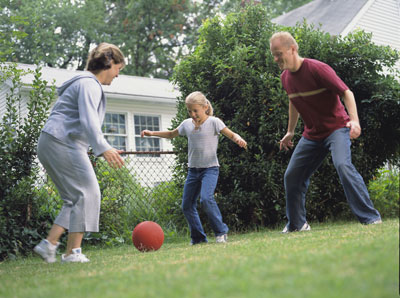Let's Move! provides the ideal opportunity to attract grandparents and grandchildren into your health or wellness center or program by providing participants with shared experiences and multidimensional health benefits, depending on the programs offered. To embrace this opportunity, you may want to incorporate the intergenerational activities below into your programming, or use them as a springboard for other ideas.
1. Walking the World
Start this walking program by describing the reasons why walking is good for health and how to make walking workouts enjoyable. Create an adventure for grandparents and grandchildren by making the goal to circle the globe. Ask participants to count their steps with pedometers and to write down their results. Pin a map on the wall to track progress, and count each step towards mileage. Recognize efforts by enrolling grandparents and grandchildren in the President's Challenge.
2. Family Album
Invite grandparents to bring photographs from the family album. Encourage them to use these images to talk about the past, allowing grandchildren to ask questions and discover more about their grandparents. Introduce an extra level to this program by suggesting that grandparents help grandchildren begin a photo album of their own.
3. Scavenger Hunt
Create a list of small things for grandparents and grandchildren to search for on a walk. Include items appropriate to your environment, e.g. a paper clip, a leaf, a white stone. Count the number of scavenged items each pair has at the end of the walk. Let the pair with the most things choose the next adventure.
4. Book-lovers Club
Ask grandparents and grandchildren to read books together, with the goal of discussing them at monthly Book Lovers meetings. Encourage participants to discuss the books they've read with other members of the club. Prepare for an enthusiastic exchange between book lovers, young and old.
5. Group Exercise
Make group exercise opportunities for the whole family. Offer classes in tai chi, swimming, yoga or group fitness, for example. Give dance classes for families. Come up with dances and name them after families participating in the program. Consider having family nights a few times a week.
6. Life Stage
Start a theater group to offer creative fun for grandparents and grandchildren. Ask the participants to write, produce and direct a year-end play for the theater group to perform. Urge them to come up with an active, fun play. Invite family members to the performance.
7. Tennis for Two
Offer tennis classes for grandparents and grandchildren at a special intergenerational rate. At the season's end, organize a tennis tournament in which participants play other intergenerational pairs. Suggest that grandparents and grandchildren invite other family members to watch or join in the fun. Provide fun awards to program participants, and be creative when coming up with award categories. When the tournament ends, throw a party to recruit other family members for the upcoming season.
8. PC Pals
Provide intergenerational computer classes, which allow grandchildren to help grandparents learn basic computer knowledge. Encourage family groups to use the computer to communicate.
9. Family Play
Devise activities that provide all family members with opportunities to work out together, e.g. outdoor hikes, biking or walking trips, or sports days. Host a family Olympics, with fun events and categories for all family members. Ensure that activities are accessible for all participants.

10. The Learning Files
Help grandparents share their skills and talents with younger family members by giving them opportunities to teach grandchildren - even if they are learning a topic themselves. Make lesson plans fun and easy. Give tomorrow's plan to grandparents, so they can prepare to teach grandchildren about subjects such as meal planning, reading food labels, or choosing the right footwear for an activity.
Relationships with grandchildren bring love, energy, play and purpose into the lives of older adults. In return, children benefit from the attention, maturity, knowledge and love of their grandparents, many of whom are caring and thoughtful role models. By creating programs that bring together these family members, you can provide individuals with healthier futures and valued life experiences, while improving your bottom line.





